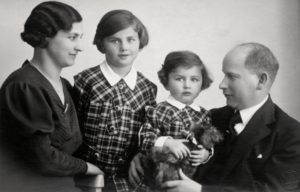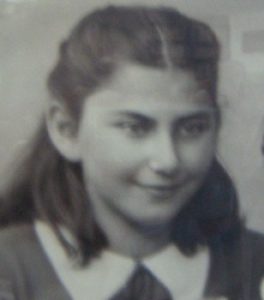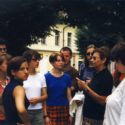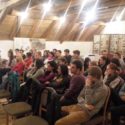
Dagmar as a five-year-old girl with her younger sister and parents, 1934. Private archive of Dagmar Lieblova
The life story of Mrs. Dagmar begins in 1929, when the Fantls cheered over the new born baby girl Dagmar in Kutna Hora. About three years later a younger baby girl Rita made the family complete. Father was a doctor with a surgery right on the ground floor of the Fantls’ house. Mother’s parents also lived in the house, together with a maid Fanny, who later played an important part in the life of Dagmar and all her family. They all lived happy and content lives spending their free time e.g. at Macha’s Lake. Dagmar was surrounded by a branched loving family, cousins, uncles, aunts, grandparents.
In March 1939, after the Nazi occupation of our country, anti-Jewish regulations also impinged on the Fantls family. The deportation to the Terezin ghetto came in early June 1942; the Fantls were assigned to transport labelled AAb. Mrs. Dagmar remembers that actually since the autumn of 1941, when the transports began, almost the only topic of conversation in Jewish families was what to pack along to the ghetto. Before leaving, the parents managed to hide a lot of important things at their maid Fanny.
In Terezin, father worked as a doctor and mother as a cleaning lady. Dagmar stayed in the girl’s home. During the day she went to work in agriculture, in the evenings she took part in singing, narrating and other activities. Dagmar also sang in the choir of the children’s opera Brundibar. From time to time Fanny sent them packages to the ghetto and so a little improved their weak food rations. In December 1943 Dagmar was together with her parents and sister put on a transport to the East. The destination was Auschwitz-Birkenau, so-called Terezin family camp. Here they were gradually learning about the terrifying reality of the place. Dagmar was fifteen years old at that time and she remembers how she thought that she would never see the forest, never see home … In July 1944 the selection came.

Young lady Dagmar in early 1942, a few months before the transport to Terezin. Private archive of Dagmar Lieblova.
Women able to work and within the age range of 16-40 should be chosen for work. None of the Fantls family met the defined criteria for transport; both sisters, Dagmar and Rita, were younger, and mother was already more than 40 years old. Incidentally, there was a mistake made at that time fifteen Dagmar. Someone had changed her date of birth from 1929 to 1925, and thus she was considered to be nineteen years old and called out by the “block leader” to selection. Dagmar tried to correct the mistake, but the “block leader” dismissed it saying that what was written was relevant. This someone’s “mistake” saved Dagmar’s life.
She was deported with other women from Auschwitz to Hamburg. She spent the next nine months with hard labour helping to clear away debris after the bombing. In March 1945, she got into the concentration camp Bergen-Belsen. In the local hell, among dead bodies, almost without food and water, she was liberated by the British Army.
Dagmar came back home to Kutna Hora, where she met Fanny again. Her parents and sister Rita had died in Auschwitz. The whole three years after the war Dagmar cured of the consequences of war detention, and then she returned to school. She studied Czech-German at the Charles University Faculty of Arts. She has taught at various schools, last few decades she has worked at the Department of Translation and Interpreting of the Faculty of Arts at CharlesUniversity.
After 1989 she set up, along with other survivors, the Terezin Initiative, whose chairwoman she has been for many years. Within the scope of Initiative activities, like many other witnesses, Mrs. Dagmar spends a lot of time with pupils and students around the Czech Republic and abroad, she tells them about her life, about the historical context of the Holocaust, about her relationship to Germany and German. She considers it to be one of the most important things – taking care that these events and individual victims of persecution would never be forgotten.
Se
Note.: A short film about lifestory of Mrs. Dagmar Lieblova was created for Centropa project, you can watch it HERE.
- Dagmar Lieblová s německými studenty v Terezíně, r. 1998
- Dagmar Lieblová se studenty Gymnázia Bohumín na půdě Magdeburských kasáren, říjen 2013




